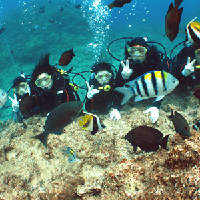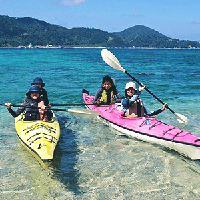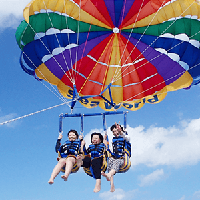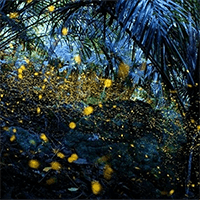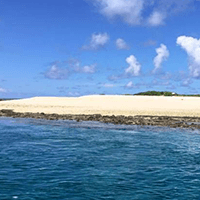List of Izu
- Age 1~Age 70
- Over 6 hours on the day
- 08:40 / 09:50
Get on and off at the meeting point08:40▼Nihonbashi Station Exit 2 (Namba-Shinsaibashi area)09:50▼Kyoto Station Hachijo Exit (in front of 7-Eleven)10:30▼Kinkaku-ji Temple (approx. 40 mins)Visiting fees are at the customer's expense.12:00▼Kiyomizu-dera Temple area (individual visit, free stroll, lunch on your own / approx. 3.5 hours)15:30▼Fushimi Inari Taisha Shrine (approx. 70 mins)17:00▼After enjoying the day's itinerary, start heading back.19:00▼Shinsaibashi, Dotonbori area (free stroll / approx. 1 hour)This is a shared tour, and participants come from all over the world.
- Age 1~Age 70
- Over 6 hours on the day
- 07:30
07:30-08:30: Pick-up/drop-off/transfer to hotel/private inn Hotels/private inns within the Osaka Loop Line 10:00 ▼ Kiyomizu-dera area (individual worship, free stroll, free lunch/approximately 3 hours) Recommended sightseeing course Course 1: Kiyomizu-dera (customer pays admission fee) - Ni-san-nen-zaka - Ishibe-koji - Gion·Hanami-koji-dori - Yasaka Shrine You can visit your favorite spots according to your stamina and time~Course 2: Kimono experience (Customers who are interested can wear a kimono and enjoy the old townscape and touring Kiyomizu-dera Temple. Let's take pictures of the wonderful moment.) (There are many kimono shops near Kiyomizu-dera Temple and Fushimi Inari Taisha Shrine. We recommend renting a kimono at a shop at Kiyomizu-dera Temple and returning it at a shop at Fushimi Inari Taisha Shrine. The fee is at the customer's expense.) 13:30 ▼ Fushimi Inari Taisha Shrine (individual visit and free stroll / about 70 minutes) 16:00 ▼ Nara Park (individual visit and free stroll / about 1.5 hours) "Deer and autumn leaves" interweave "Nara Park" The contrast between the autumn leaves and evergreen trees is vivid Recommended tourist spot [Todaiji Temple] (Admission fee is at the customer's expense.) Todaiji Temple was built during the Nara period. Nara is popular with tourists and once served as the capital of Japan. It is registered as a World Heritage Site as one of the "Cultural Monuments of Ancient Nara" by UNESCO. Todaiji Temple has eight national treasure buildings, 14 buildings with 24 national treasure Buddha statues, and nine other national treasures, including paintings and books. The famous Great Buddha, the Great South Gate, the Kongorikishi statues, and the Hokkedo Hall, as well as the Buddha statues enshrined within, are all national treasures. There are very few places in Japan where you can see so many national treasures at once. Admission fees: Todaiji Temple Great Buddha Hall: 600 yen for adults (junior high school students and above), 300 yen for elementary school students; Great Buddha Hall and Todaiji Museum: 1000 yen for adults (junior high school students and above), 400 yen for elementary school students 17:30▼After a fun day of sightseeing, we start to head back. 18:30Shinsaibashi, Dotonbori area (Guests on the course that takes you to your hotel or guesthouse should wait for the shuttle bus. When the shuttle bus arrives, we will take you back to your hotel or guesthouse and the tour will end.)This is a mixed tour, and participants come from all over the world.
- Age 1~Age 70
- Over 6 hours on the day
- 08:40 / 09:50
Boarding and disembarking at the meeting point 08:40▼Nihonbashi Station Exit 2 (Namba-Shinsaibashi area) 09:50▼Kyoto Station Hachijo Exit (in front of 7-Eleven) 10:00▼Kiyomizu-dera area (individuals must visit the temple, stroll around freely, and have lunch at their leisure / approx. 3 hours) Recommended sightseeing course Course 1: Kiyomizu-dera Temple (customers are responsible for admission fees) - Ni-Sannenzaka - Ishibekoji - Gion·Hanamikoji-dori - Yasaka Shrine You can visit your favorite spots according to your stamina and time~Course 2: Kimono experience (Customers who are interested can wear a kimono and enjoy the old townscape and touring Kiyomizu-dera Temple. Let's take pictures of the wonderful moment.) (There are many kimono shops near Kiyomizu-dera Temple and Fushimi Inari Taisha Shrine. We recommend renting a kimono at a shop at Kiyomizu-dera Temple and returning it at a shop at Fushimi Inari Taisha Shrine. The fee is at the customer's expense.) 13:30 ▼ Fushimi Inari Taisha Shrine (individual visit and free stroll / about 70 minutes) 16:00 ▼ Nara Park (individual visit and free stroll / about 1.5 hours) "Deer and autumn leaves" interweave "Nara Park" The contrast between the autumn leaves and evergreen trees is vivid Recommended tourist spot [Todaiji Temple] (Admission fee is at the customer's expense.) Todaiji Temple was built during the Nara period. Nara is popular with tourists and once served as the capital of Japan. It is registered as a World Heritage Site as one of the "Cultural Monuments of Ancient Nara" by UNESCO. Todaiji Temple has eight national treasure buildings, 14 buildings with 24 national treasure Buddha statues, and nine other national treasures including paintings and books. The famous Great Buddha, the Great South Gate, the Kongorikishi statues, and the Hokkedo Hall, as well as the Buddha statues enshrined within, are all national treasures. There are very few places in Japan where you can see so many national treasures at once. Admission fee: Todaiji Temple Great Buddha Hall: 600 yen for adults (junior high school students and above), 300 yen for elementary school students; Great Buddha Hall and Todaiji Museum: 1000 yen for adults (junior high school students and above), 400 yen for elementary school students 17:30▼After a fun day of sightseeing, we start heading back. 18:30Shinsaibashi, Dotonbori area (free time/about 1 hour)This is a mixed tour, and participants come from all over the world.
- Age 20~Age 99
- 2~3 hours /3~4 hours
- 13:00
Blessed with an abundance of underground water veins that spring up from the Momoyama Hills, Fushimi was once called "Fushimizu" (literally "fushimizu" in Japanese), and it is said that full-scale brewing began here about 400 years ago because the water was suitable for sake brewing. It flourished as a castle town and a port on the Yodo River on the Tokaido, and sake breweries with white walls stand out along the Uji River and canals. The streets of Fushimi, where you can enjoy the atmosphere of a sake brewing town, with ten-koku boats sailing among swaying willows, have been designated as the "Fushimi Minamihama Neighborhood Landscape Development District" by Kyoto City. ~Time Schedule~13:00 [Meet at the north ticket gate of Keihan Electric Railway Nakashojima Station] Meet in front of the sake barrel object located immediately after exiting the north ticket gate! This is where the tour begins! It's a flat road, but you'll be walking about 2 kilometers, so please wear comfortable shoes on the day. 13:15 [Gekkeikan Okura Sake Museum] ☆Three types of sake tastings, including Daiginjo, and a special Gekkeikan sake cup included☆The building is a wooden storehouse built in the Meiji era that is still in use. You can drink the underground water used in sake brewing from the well in the courtyard. Just like Fushimi sake, it is very soft and delicious, so please try it. You will be surprised at how soft it is. In the exhibition room, you can see traditional sake brewing tools, which are designated as tangible folk cultural properties of Kyoto City. 13:50 [Fushimi Yume Hyakushu] ☆Winter limited sake ice cream included☆Shop & cafe "Fushimi Yume Hyakushu". In fact, this building is the former main store of Gekkeikan, built in the Taisho era. In addition to Gekkeikan, various Kyoto sakes and souvenirs are sold in the store. We have prepared a 3-type sake tasting set including appetizers here. 14:30 [Kizakura Kappa Country] ☆Kyoto's oldest local beer included☆ Kiizakura is famous for its sake commercials using kappa characters, but it is also the first company to make local beer in Kyoto. Therefore, in addition to the sake manufacturing process, Fushimizugura is characterized by the fact that you can tour the beer factory. After the tour, try tasting sake and beer in the lovely courtyard. 15:15 [Aburacho] ☆Authentic sake tasting set of three types☆ We have more than 80 types of sake from all 18 breweries in Fushimi, mainly ginjo sake and daiginjo sake, and more than 100 types including seasonal limited edition sake. In addition, at the sake tasting counter attached to the store, you can compare three types in small cup size as well as a glass. Just looking at the bottles will make you feel happy.
- Age 0~Age 60
- 1~2 hours
- 10:00 / 13:00
This tour is a quiz-based version of Bura Tamori. It has been held over 30 times. Starting from JR Hakata City, you will walk through Gion and Nakasu to Tenjin Kego Shrine while answering quizzes. What, you can go through a place like this!? What? From this rare sight, to the history of the remnants of the old towns of Hakata and Fukuoka, to the historical buildings and long-established famous restaurants hidden in the changing Fukuoka, we will introduce many things. [Quiz example] Why Hakata Station and not Fukuoka Station, even though it is Fukuoka City? What is the golden XX attached to the station? What are the rules unique to Hakata people in how to eat mizutaki and the etiquette of food stalls? ? You can do XX even though you are in the middle of the city? ? What was the world's first thing born in Fukuoka before the rest of the world during the Edo period? Hakata is full of firsts in Japan. There are also these! ! There are many other Fukuoka quizzes available. Please join us without any prior preparation and enjoy walking around the city to discover Fukuoka again through the quizzes. It is full of information that you will want to tell someone about. We have prepared enough material to fill several guidebooks. By the end of the tour, we are sure you will have a different way of enjoying Fukuoka. ~Experience Outline~ (10:00 Course)10:00 Hidden secrets in JR Hakata Station! Hakata Station, Hakata Bus Terminal, Daihaku Street, Historical Street, Original Hakata Station, etc.10:20 Old Hakata City with its old streetscapeHakata Sennenmon Gate, Myorakuji Temple, Shofukuji Temple, Tochoji Temple, etc.10:40 Gion-Gofukumachi Kushida Shrine, old streetscape, bargain shopping street, origin monument, etc.11:00 Nakasu KawabataNakasu Kawabata Shopping Street, Riverwalk Hakata, redevelopment zone, etc.11:20 Nakasu → TenjinNakasu Shopping District, alleys, alleys, Across Tenjin, Tenjin Park, Tenjin Underground Shopping Mall, Kego Shrine, etc.
- Age 0~Age 100
- Within 1 hour
Atami One-Way Hands-Free PlanAtami Station → Your Luggage Will Be Delivered to Your Preferred AccommodationThis plan allows you to forget about your luggage the moment you arrive at Atami Station and enjoy Atami to the fullest.Atami Round-Trip Hands-Free PlanDay 1) Atami Station → AccommodationDay 2) Accommodation → Atami StationYou can leave your luggage at your accommodation!This plan allows you to enjoy Atami completely forgetting about your luggage.
- Age 13~Age 80
- Over 6 hours on the day
- 08:50
Welcome to KYOTO, Japan!Let's dive into and discover Kyoto's kaleidoscope of sights and sounds.Explore as many as 12 attractions in the city on this full day tour.We take you to the must-see sights and also show you the hidden gems of each location.Let's stroll the city on foot and by metro like a local for the day.Transportation and the street in the area are very complicated, even for the Japanese.However, all guide ours were born and raised in Japan, have lived for a long time close to the area, and are well-trained expert locals.So, we can take you to so many places, at the best time, within a limited timeframe.We recommend you join our tour on your first day in Tokyo. Because, you can learn not only about sights, but also about Japanese history, culture, society, ways of thinking, values and even about local etiquette, how to take public transportations, our everyday life.But above all, the best part of traveling is good food.JR Saga-Arashiyama station at 8:50Arashiyama, Randen Tram Line, Ryoan-ji Temple, Sushi-go-round(lunch, Ramen, Kara-Age, Beer), Kinkakuji Temple, Fushimi Inari Shrine, Kiyomizu-zaka slope, Kiyomizu Temple, Sanneizaka, Yasaka Pagoda, Gion area, Gion shopping street
- Age 3~Age 100
- 2~3 hours
- 10:00 / 13:00
This is an experience program unique to Shizuoka, the tea-producing region, where you can learn about tea from farmers at a tea plantation where high-quality tea is produced using the Chagusaba farming method, a World Agricultural Heritage site, and enjoy a sencha ceremony where you brew delicious tea yourself in a teapot. Also, with this plan, you can enjoy a tea ceremony at the old Tokaido 53 Station Hisaka-juku and an old inn from the Edo period. ~Flow of the experience~ (You can choose morning session or afternoon session) 10:00/13:00 Tabinosha meeting/reception 10:15/13:15 Tea learning experience with tea farmers at the tea plantation (tea season) There is also a tea picking experience (approx. 30 minutes) 11:00/14:00 Experience comparing three types of tea drinking at the old private house of Hisaka-shuku Motoiyaba (approx. 40 minutes) 11:40/14:40 Tokaido Fifty Stroll around the post town of Miyoshi with a local guide (approx. 20 minutes) 12:10/15:10 Receive tea bottles and tea bags as souvenirs at Tabinosha, then leave.
- Age 3~Age 100
- 2~3 hours
- 10:00 / 13:00
This is an experience program unique to Shizuoka, the tea-producing region, where you can learn about tea from farmers at a tea plantation where high-quality tea is produced using the Chagusaba farming method, a World Agricultural Heritage Site, and enjoy a time spent making delicious tea with the tea farmers. ~Procedure of the experience~ 10:00/13:00 Gather at Tabinosha/Reception 10:15/13:15 Spend time in the tea fields talking with farmers and helping with their work. During the tea break, enjoy a tea ceremony with delicious tea brewed by farmers! (approx. 60 minutes) 11:20/14:20 Try tasting Higashiyama tea at Higashiyama Ippukudokoro (approx. 25 minutes) 12:00/15:00 Receive tea bottles and tea packs as souvenirs at Tabinosha ,dissolution
- Age 3~Age 100
- 2~3 hours
- 10:00 / 13:00
This is an experience program unique to Shizuoka, the tea-producing region, where you can learn about tea from farmers at a tea plantation where high-quality tea is produced using the Chagusaba farming method, a World Agricultural Heritage site, and enjoy a sencha ceremony where you brew delicious tea yourself in a teapot. In addition, with this plan, you will enjoy a tea-filled time at ``Chamonji no Sato Higashiyama'', the area's premier tea producing area. ~ Flow of the experience ~ 10:00/13:00 Higashiyama Ipukudokoro: Deep steamed tea drinking comparison (about 30 minutes) 10:40/13:40 Information on Chagusaba farming at the tea plantation (tea picking experience available during tea season) (about 30 minutes) 11:20/14:20 Tea party with sencha brewed in a teapot on the terrace at the summit of Mt. Awagatake (about 30 minutes) 12:10/15:10 Souvenirs of tea bottles and tea bags at Higashiyama Ipukudokoro Disband after receiving
- Age 12~Age 100
- 5~6 hours
- 15:30
Shizuoka has flourished as a post town on the Tokaido road since the Edo period and as a tea-producing region. Please enjoy the unique "Chaji" experience that continues to cherish the history and culture of Shizuoka through local daily life and festivals. "Chaji CHAJI ~ Iki~" is a top-class banquet where you can fully enjoy the culture of a post town on the Tokaido road.・Duration: Approximately 5 hours ・Meals: Traveler's Kaiseki ・Traditional performing arts: Either Nagauta, Shamisen or Japanese dance ・General schedule: ⑴ A curator or local guide will introduce and explain the local history and culture of the Tokaido post town, which has been nurtured by the tea industry ⑵ A performance of one of the traditional performing arts, Nagauta, Shamisen or Japanese dance, which has been passed down in the culture of the post town ⑶ Kaiseki cuisine that pairs well with green tea and local sake ⑷ A tea ceremony with local sencha and sweets by a tea farmer or tea master ~Experience flow~ Experience a banquet "Chaji" where you can enjoy "Shizuoka green tea", the number one tea producing region in Japan, and "400 years of Tokaido post town culture" Iki plan *We will pick you up by taxi from Kakegawa Station, Shimada Station, or your accommodation in Kakegawa or Shimada city. ●Meeting place: Fujibun (Kakegawa City) or Sakurai Residence (Shimada City) 15:30●Greetings and explanations 15:30 - 16:00 Introducing the unique story of Tokaido post town culture and tea culture in this area ☆Kawasakaya (Kakegawa City): Guided tour of Hizaka-juku in the Edo period by the Kawasakaya Association and performance of Hizaka Mago Utagi ☆Oigawa Kawagoe Ruins (Shimada City): Guided tour of the Kawagoe system in the Edo period while touring the meeting hall, jin'ya, Sakurai Residence, etc. ●Yorozuya (Kakegawa City) or Sakurai Residence (Shimada City) 16:10 - 17:10 Traditional performing arts performance Either shamisen, nagauta, or Japanese dance ●Fujibun (Kakegawa City) or Sakurai Residence (Shimada City) 17:20 - 18:20 ☆Tea party with local sencha *A recreation of "ame no mochi" (candy rice cake), which is said to have been a favorite of Tokugawa Ieyasu, will be served as a tea snack. *Kappo Uomitsu (Kakegawa City) or Sakurai House (Shimada City) 18:40 - 20:00 ☆Kaiseki cuisine that combines green tea and local sake ☆After greetings, disband around 20:10 *We will take you by taxi to Kakegawa Station, Shimada Station, or your accommodation in Kakegawa or Shimada City. *The itinerary may change depending on the season, weather, and other circumstances, as well as the venue.
- Age 12~Age 100
- Over 6 hours on the day
- 14:00
Shizuoka has flourished as a post town on the Tokaido road since the Edo period and as a tea-producing region. Please enjoy the unique "Chaji" experience that continues to cherish the history and culture of Shizuoka through local daily life and festivals. "Chaji CHAJI ~Hana~" is a top-class banquet where you can fully enjoy the culture of Tokaido post towns. Duration: Approximately 6 hours Meal contents: Kaiseki cuisine for senior retainers Traditional performing arts: Nagauta, shamisen or Japanese dance. Performing arts experience: Experience either shamisen or Japanese dance. Outline schedule: 1. Explanation and guide from producers at tea plantations cultivated using the Chagusaba method, a World Agricultural Heritage System. 2. Explanation and guide from curators and local guides about the history and culture of the Tokaido post towns and tea industry. 3. Performance of one of the traditional performing arts passed down in the post town culture: Nagauta, shamisen or Japanese dance. 4. Kaiseki cuisine that pairs well with green tea and local sake. 5. Tea ceremony with local sencha and sweets by tea farmers or tea masters. ~Experience flow~ Experience a banquet "Chaji" where you can enjoy "Shizuoka green tea", the number one tea producing region in Japan, and "400 years of Tokaido post town culture". Hana Plan *We will pick you up by taxi from Kakegawa Station, Shimada Station, or your accommodation in Kakegawa or Shimada City. 00~17:10 English: ●Meeting place: Fujibun (Kakegawa City) or Sakurai Residence (Shimada City) 14:00●Greetings and explanations Learn about the unique stories of Tokaido post town culture and tea culture in this area 14:00 - 14:20 → (Travel by private vehicle) → ●Tea fields A tea farmer will explain local tea cultivation 14:35 - 15:05 (Tea picking experience depending on the season) → (Travel by private vehicle) → ●Kawasakaya (Kakegawa City) or Sakurai Residence (Shimada City) 15:20 - 16:00 Kawasakaya: Guided tour of Hizaka-juku in the Edo period by the Kawasakaya Association and performance of the Hizaka Mago-uta song Oigawa Kawagoe Ruins: Guided tour of the Kawagoe system in the Edo period while touring the meeting hall, jin'ya, Sakurai Residence, etc. ●Yorozuya (Kakegawa City) or Sakurai Residence (Shimada City) 16:10 - 17:10 Traditional performing arts performance and experience Either shamisen, Nagauta, or Japanese dance ●Fujibun (Kakegawa City) or Sakurai House (Shimada City) 17:20 - 18:20 ☆Tea party with local sencha tea ※A tea snack made with a replica of "ame no mochi" (candy mochi), which is said to have been a favorite of Tokugawa Ieyasu ●Kappo Uomitsu (Kakegawa City) or Sakurai House (Shimada City) 18:40 - 20:00 ☆Kaiseki cuisine with a marriage of green tea and local sake ☆After greetings, disband around 20:10 ※We will take you by taxi to Kakegawa Station or Shimada Station or to your accommodation in Kakegawa or Shimada City. ※The itinerary may change depending on the season, weather, and other circumstances, as well as the venue.
- Age 12~Age 100
- Over 6 hours on the day
- 13:00
Shizuoka has flourished as a post town on the Tokaido road since the Edo period and as a tea-producing region. Please enjoy the unique "Chaji" experience that continues to cherish the history and culture of Shizuoka through local daily life and festivals. "Chaji CHAJI ~ Miyabi ~" is a top-class banquet where you can fully enjoy the culture of a Tokaido post town. Duration: Approximately 7 hours Meal content: Lord's kaiseki cuisine Traditional performing arts: High-class kimono, Nagauta, shamisen, and Japanese dance Performance experience: Shamisen and Japanese dance experience Outline schedule: 1. Explanations and tours from producers at tea plantations cultivated using the Chagusaba method, a Globally Important Agricultural Heritage System 2. Curators and local guides introduce the history and culture of this Tokaido post town, nurtured by the tea industry 3. A performance of traditional performing arts that are passed down in post town culture, such as Nagauta, shamisen, and Japanese dance 4. Experience the kimono culture that has been cultivated in Shimada-juku, famous for its obi festival that has been passed down since the Edo period, by trying on a kimono 5. Kaiseki cuisine that pairs well with green tea and local sake ⑹ Tea ceremony with local Sencha tea and sweets by a tea farmer or tea master. ~Experience process~ *We will pick you up by taxi from Kakegawa Station, Shimada Station, or your accommodation in Kakegawa or Shimada City. 00~17:10 English: ●Meeting place: Fujibun (Kakegawa City) or Sakurai Residence (Shimada City) 13:00●Greetings and explanations Learn about the unique stories of Tokaido post town culture and tea culture in this area 13:00 - 13:20 → (Travel by private vehicle) → ●Tea fields A tea farmer will explain about local tea cultivation 13:30 - 14:10 (Tea picking experience depending on the season) → (Travel by private vehicle) → ●Kawasakaya (Kakegawa City) or Sakurai Residence (Shimada City) 14:30 - 15:00 Kawasakaya: Guided tour of Hizaka-juku in the Edo period by the Kawasakaya Association and performance of the Hizaka Mago-uta song Oigawa Kawagoe Ruins: Guided tour of the Kawagoe system in the Edo period while touring the meeting hall, jin'ya, Sakurai Residence, etc. ●Yorozuya (Kakegawa City) or Sakurai Residence (Shimada City) 15:10 - 17:10 Traditional performing arts performance and experience Shamisen, Nagauta, and dancing 15:20 - 16:20 ☆ Kimono dressing experience (limited number) 16:20 - 17:20 ● Fujibun (Kakegawa City) or Sakurai House (Shimada City) 17:20 - 18;20 ☆ Tea ceremony with local sencha ※ A reproduction of "ame no mochi" (candy mochi), which is said to have been a favorite of Tokugawa Ieyasu, is served as a tea snack ● Kappo Uomitsu (Kakegawa City) or Sakurai House (Shimada City) 18:40 - 20:00 ☆ Kaiseki cuisine with green tea and local sake ☆ After greetings, disband Around 20:10 * We will take you by taxi to Kakegawa Station or Shimada Station or your accommodation in Kakegawa City or Shimada City. * The itinerary may change depending on the season, weather, and other circumstances, and depending on the venue.
- Age 6~Age 99
- 1~2 hours
- 13:00
When most people think of Takarazuka, they think of the Takarazuka Revue, but surprisingly, there are not only operas, but also hot springs, memorial halls, and other attractions around Takarazuka Station. After the performance in Takarazuka, why don't you take a walk around the city from a different side with a tour guide? There will surely be new discoveries! ~Time schedule~ 13:00 [Meet in front of the Hankyu Takarazuka station ticket gate] The tour starts here! Although the road is flat, you will walk about 2 kilometers, so please wear comfortable shoes on the day. 13:10 [Birthplace of Carbonated Rice Crackers and Wilkinson Vending Machine] The popular carbonated water "Wilkinson Tansan" when drinking a highball. Did you know that this "Wilkinson Tansan" originated in Takarazuka? In front of Takarazuka Onsen, there is an all-Wilkinson vending machine only here in Japan. 13:20 [Takarazuka Onsen Hotel Wakamizu] During the Showa era, Takarazuka Family Land and hot springs were located along the Muko River, and it was a prosperous resort. There are only a few hotels in operation now, but the atmosphere of the hot spring town of yesteryear still lingers in the air. 13:40 [Takarazuka Ohashi] After passing Takarazuka Onsen, a large tower apartment is currently under construction on the site where the "Takarazuka Hotel", which was founded in 1923, used to be. Please take a look at the town of Takarazuka, which has been renewed with the changing times. The view from Takarazuka Bridge is a great photo spot. The set of Takarazuka Opera, Hankyu Railway and Mukogawa can only be seen here. The sidewalk of Ohashi is also spacious, so you can take pictures slowly. (Every 30 minutes on the hour, the fountain "Big Phoenix" rises from the Muko River, so if you're lucky, you can see it.) 13:55 [Tezuka Osamu Memorial Museum] Did you know that Mr. Osamu Tezuka was actually from Takarazuka? Uka Born in Toyonaka City, Osaka Prefecture in 1928, I lived in Takarazuka City, Hyogo Prefecture from the age of 5, when I was just starting to understand things, to my sensitive boyhood, and until I was about to enter adulthood when I was 24. A museum has been built in Takarazuka to commemorate his achievements, not only as a city where he once lived, but also as a city that gave the underlying theme of all Tezuka manga. 14:40 [Hana no Michi] I think it goes without saying for Takarazuka fans, but it seems that Hana no Michi also means a flower path to the Takarazuka Grand Theater. It is truly a “flower path to the world of dreams”. There are bronze statues of opera performances such as "The Rose of Versailles" and a bronze statue of "Ichizo Kobayashi", the founder of Hankyu Corporation and the Takarazuka Revue. 14:50 [Takarazuka Hotel] There is a newly relocated Takarazuka Hotel in the middle of Hananomichi. In 2009, the Takarazuka Hotel was selected as the official hotel of the Takarazuka Grand Theater with the concept of "continuing your dreams here." Please take a look at the dignified appearance. 15:00 [Arrival at Takarazuka Station]
- Age 12~Age 80
- 3~4 hours
- 13:00
From the station front of Izu Inatori, take the bus bound for Izu Animal Kingdom at 13:10 and depart. From Izu Mikan Winery, walk the shortest route of the cross-country course. After enjoying the view of the observatory, descend on the 60-meter slide. If you wish, it is the content of the course that you will walk to the station after tea time at a cafe with a nice view on the way.
- Age 3~Age 100
- 5~6 hours
- 10:00
This is an experience program unique to Shizuoka, the tea-producing region, where you can learn about tea from farmers at a tea plantation where high-quality tea is produced using the Chagusaba farming method, a World Agricultural Heritage site, and enjoy a sencha ceremony where you brew delicious tea yourself in a teapot. In addition, this plan will visit the production areas of two of the three major tea brands in Shizuoka, ``Mountain Tea Kawane Tea'' and ``Fukasteamed Tea Kakegawa Tea'', hear from the producers, and have the opportunity to taste and compare teas. Recommended for those who love tea! ~Procedure of the experience~ 10:00 Gather at Higashiyama Ipuku-dokoro and compare the tastes of Higashiyama tea (approx. 30 minutes) 10:40 Tea plantation Explanation about Chagusaba farming from the farmers (approx. 30 minutes) 11:40 Local cuisine: ``Japanese yam yam soup'' ” Lunch (approx. 40 minutes) 12:30 Tea Miyako Museum Learn about Japanese green tea and teas from other countries (approx. 60 minutes) 14:30 Tea plantation Interact with farmers who produce Kawane tea (approx. 60 minutes)
- Age 3~Age 100
- 2~3 hours
- 10:00 / 13:00
World Agricultural Heritage Site Learn about tea from farmers at a tea plantation where high-quality tea is produced using the Chagusaba farming method, learn about tea distribution from a tea shop called a tea merchant, and meet the masters of tea-tasting tea distributed in the market. This is a special experience program to enjoy. ~ Flow of the experience ~ 10:00/13:00 Gather at Tabinosha/Reception 10:15/13:15 Interaction with tea farmers at the tea plantation (during tea season, you can experience tea picking) Approximately 30 minutes 10:55/13 :55 Tour of the processing plant and tea tasting experience at a tea shop Approximately 60 minutes 12:00/15:00 Receive tea bottles and tea bags as souvenirs at Tabinosha, then dismiss.
- Age 20~Age 99
- 3~4 hours
- 13:00
A visit to a sake brewery is a must on any trip to the Kansai region of Japan. Nada Ward in Kobe City is the place with the largest production of sake in Japan, and there are about 30 sake breweries in the area called "Nada Gogo", which stretches 24km from east to west. The history of sake brewing dates back to around 1330. Speaking of "Nada's sake", it is so famous that it appears in classic rakugo, and Nada is blessed with various conditions suitable for sake brewing. Mineral-rich hard water called "Miyamizu", the production area of "Yamada Nishiki", which is famous as "the king of sake rice", and "Rokko Oroshi" blowing down from Mt. Rokko bring a cold and optimal climate. This tour will take you to 3 carefully selected locations and sample over 25 different types of sake. A guide who is familiar with sake and the Nada area will guide you to the profound world of sake. ~ Flow of the day ~ 13:00 Meet in front of the ticket gate of Ishiyagawa Station (Hanshin Line) 13:30 1st place Sake brewery With a history of over 250 years, it is the smallest sake brewery in Nada Ward, and the production volume is 1.8 bottles ( 1.8L) It is a small scale of about 40,000 bottles. Although the scale is small, there are well-known high-quality brands that are known all over Japan. You will be able to taste mainly unpasteurized sake (liquor with live yeast) that can only be enjoyed in Japan. This yuzu sake is the best! *We are not open on Saturdays and Sundays, so we will take you to another sake brewery. note that. 14:00 2nd place Sake brewery Founded in 1751, the president is the 13th generation brewery. There are a wide variety of authentic sake, including "Junmai Ginjo", which has been served at the Nobel Prize banquet five times in the past. The souvenir corner has a wide variety of snacks, sake bottles, masu, and more. Tasting with an explanation from the brewer is always very popular with tourists! 15:00 3rd Place Sake Brewery This is the biggest sake brewery in Japan. There is a museum that exhibits the traditional construction methods. Wear a happi coat and take a memorable photo at a commemorative photo spot. 15:30 4th place In Sakagura Nada Ward, it's a small sake brewery, but a sake master with over 60 years of experience will serve you sake. While making traditional, high-quality sake, it is also innovative and rich in variety. For example, there are whiskeys that have been aged in American oak for 14 years, sherry that has been aged in brandy barrels for 14 years, and sake that is a blend of white wine Chardonnay and sake. The image of Japanese sake will be overturned. This is optional, and there is a paid tasting counter. You can enjoy a small plate of cheese made from dairy cows raised on Mt. Rokko and the finest Shizukuzake. 16:30 Leave Uozaki Station (Hanshin Line)
- Age 12~Age 99
- 4~5 hours
- 09:50
<Points of this plan> ・ Full-scale cooking experience using local seasonal ingredients based on local cooking research ・ A certified guide will guide you to spots where you can feel local life such as shrines and markets. ・ Walk in a local back alley full of life that is not often used for sightseeing First, head to IN KANAZAWA HOUSE through a narrow alley full of life, with a glimpse of the everyday life of the locals. IN KANAZAWA HOUSE is a traditional Kanazawa Machiya-style building where you can feel the lifestyle of those days. The traditional townhouse has a large, renovated kitchen where you can experience cooking home-cooked meals. A cooking researcher born in Kanazawa will teach you special recipes using seasonal ingredients. The cooking process will be explained with demonstrations such as how to make soup stock, and home-cooked dishes will be handed down locally. When it's done, it's finally a fun meal. After a meal, take a photo at the townhouse, explore, relax while looking at the garden, and relax. 《Weekly menu》 Sushi course Oshizushi (Ishikawa's specialty), omelet, boiled plum shellfish, 1 local dish (4 dishes in total) Tempura course Tempura using seasonal seafood and vegetables, omelet, soup, local dish (4 items in total), rice ~ Flow of the day ~ 9:50 Kanazawa Station East Exit Tourist Information Center "Hyakuman-san" Meeting / Check-in 10:00 Walk from Kanazawa Station (about 1km) An English tourist guide will guide you. Cooking experience of home cooking at IN KANAZAWA HOUSE 14:00 Dissolution in front of Kanazawa Station
最近チェックしたプラン
Please wait a moment
![[Day trip | Pick-up from city hotels] Ancient Kyoto Japanese-style tour: Kinkaku-ji Temple - Kiyomizu-dera Temple - Fushimi Inari Taisha Shrineの画像](https://img.activityjapan.com/10/55487/10000005548701_P3BiVCAd_3.jpg?version=1733822342)
![[13-person team/Pick-up from city hotels] Kyoto, Nara, Kiyomizu-dera Temple, Kimono experience, Yasaka Shrine, Fushimi Inari Taisha Shrine, Nara Parkの画像](https://img.activityjapan.com/10/55578/10000005557801_P3BiVCAd_3.jpg?version=1722496202)
![[Day Trip] Kyoto, Nara, Kiyomizu-dera Temple, Kimono Experience, Yasaka Shrine, Fushimi Inari Taisha Shrine, Nara Park, Todaiji Temple Day Trip (Departing from Osaka/Kyoto)の画像](https://img.activityjapan.com/10/55460/10000005546001_P3BiVCAd_3.jpg?version=1730786226)

![[Fukuoka/Hakata] Fukuoka City Walk "Adult school trip with quizzes" Japan's only quiz trip! Alone, first time in Fukuoka, quiz beginners welcome! You can do it empty-handed!の画像](https://img.activityjapan.com/10/51236/10000005123601_atFOJjl6_3.jpg?version=1697681467)
![[Shizuoka/Atami] Atami empty-handed planの画像](https://img.activityjapan.com/10/57226/10000005722601_ntZ3nnUe_3.jpg?version=1734573905)
![[Kyoto] Complete Kyoto Tour in One Day, Explore All 12 Popular Sights!の画像](https://img.activityjapan.com/10/52322/10000005232201_z8QiQozH_3.jpg?version=1703416682)
![[Shizuoka/Kakegawa] Travel back in time to Edo period travelers at "53 Stations of the Tokaido Hisaka-juku"! A walk through a tea field designated as a World Agricultural Heritage site and a tea party with Sencha in Tokaido, Hisaka-juku, Kakegawaの画像](https://img.activityjapan.com/10/53174/10000005317401_7QZyrSGm_3.JPG?version=1709892669)
![[Shizuoka/Kakegawa] ~ Tea time where you can enjoy interacting with tea farmers ~ Tea party with tea plantation walk and sencha in tea plantationの画像](https://img.activityjapan.com/10/53169/10000005316901_7QZyrSGm_3.jpg?version=1709902687)
![[Shizuoka/Kakegawa] Enjoy high-quality deep-steamed tea using the Chagusaba farming method, a world agricultural heritage site! Tea plantation walk and sencha tea party in Chamonji no Sato Higashiyama/Kakegawaの画像](https://img.activityjapan.com/10/53171/10000005317101_7QZyrSGm_3.JPG?version=1709904071)
![[Shizuoka/Kakegawa] Experience the "Chaji" banquet to enjoy "Shizuoka green tea" from Japan's number one tea producing region and "400 years of Tokaido post town culture" with the "Iki Plan"の画像](https://img.activityjapan.com/10/56772/10000005677201_AVWlGGNt_3.jpg?version=1730975102)
![[Shizuoka/Kakegawa] Experience the "Chaji" banquet to enjoy "Shizuoka green tea" from Japan's number one tea producing region and "400 years of Tokaido post town culture" Hana Planの画像](https://img.activityjapan.com/10/56748/10000005674801_AVWlGGNt_3.jpg?version=1730976666)
![[Shizuoka/Kakegawa] Experience the "Chaji" banquet to enjoy "Shizuoka green tea" from Japan's number one tea producing region and "400 years of Tokaido post town culture" Miyabi planの画像](https://img.activityjapan.com/10/56746/10000005674601_AVWlGGNt_3.jpg?version=1730976485)
![[Hyogo/Takarazuka] A 2-hour walking tour to discover new things in Takarazuka! Also introduced in Bra Tamori! Parents and children and one person are also welcome *Guide includedの画像](https://img.activityjapan.com/10/44053/10000004405301_5u86vXcx_3.png?version=1681196347)
![[Shizuoka Prefecture, Higashiizu Inatori] A straight walk plan from the mountain of Inatori to the port! You can overlook the port city.の画像](https://img.activityjapan.com/10/39343/10000003934301_o5IOmYss_3.jpg?version=1639646645)
![[Shizuoka/Kakegawa] ~ A full day tea trip tour visiting the 2 major Shizuoka tea brand areas ~ World industrial heritage tea plantation walk and sencha tea party in Kakegawa tea VS Kawane teaの画像](https://img.activityjapan.com/10/53044/10000005304401_7QZyrSGm_3.JPG?version=1709905754)
![[Shizuoka/Kakegawa] ~ Tea tasting experience at a professional tea shop ~ Tea plantation walk and sencha tea party in tea shopの画像](https://img.activityjapan.com/10/53042/10000005304201_7QZyrSGm_3.JPG?version=1709906531)

![[Ishikawa / Kanazawa] Experience local cooking in Kanazawa and experience local life at the local back alley "Market"の画像](https://img.activityjapan.com/10/35783/10000003578301_mBDQW4j9_3.jpg?version=1612754910)

